
The Southwest Chief is a long-distance passenger train operated by Amtrak on a 2,265-mile (3,645 km) route between Chicago and Los Angeles through the Midwest and Southwest via Kansas City, Albuquerque, and Flagstaff mostly on the BNSF's Southern Transcon, but branches off between Albuquerque and Kansas City via the Topeka, La Junta, Raton, and Glorieta Subdivision. Amtrak bills the route as one of its most scenic, with views of the Painted Desert and the Red Cliffs of Sedona, as well as the plains of Illinois, Missouri, Kansas, and Colorado.

The Atchison, Topeka and Santa Fe Railway, often referred to as the Santa Fe or AT&SF, was one of the largest Class 1 railroads in the United States between 1859 and 1996.

The Super Chief was one of the named passenger trains and the flagship of the Atchison, Topeka and Santa Fe Railway. The then-modern streamliner was touted in its heyday as "The Train of the Stars" because it often carried celebrities between Chicago, Illinois, and Los Angeles, California.
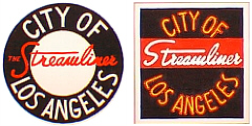
The City of Los Angeles was a streamlined passenger train between Chicago, Illinois, and Los Angeles, California via Omaha, Nebraska, and Ogden, Utah. Between Omaha and Los Angeles it ran on the Union Pacific Railroad; east of Omaha it ran on the Chicago and North Western Railway until October 1955 and on the Milwaukee Road thereafter. The train had number 103 westbound and number 104 eastbound.
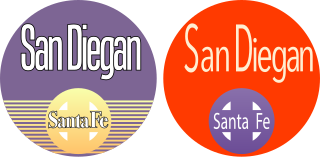
The San Diegan was one of the named passenger trains of the Atchison, Topeka and Santa Fe Railway, and a “workhorse” of the railroad. Its 126-mile (203-kilometer) route ran from Los Angeles, California, south to San Diego. It was assigned train Nos. 70–79.

The El Capitan was a streamlined passenger train operated by the Atchison, Topeka and Santa Fe Railway between Chicago, Illinois, and Los Angeles, California. It operated from 1938 to 1971; Amtrak retained the name until 1973. The El Capitan was the only all-coach or "chair car" to operate on the Santa Fe main line between Chicago and Los Angeles on the same fast schedule as the railroad's premier all-Pullman Super Chief. It was also the first train to receive the pioneering Hi-Level equipment with which it would become synonymous.
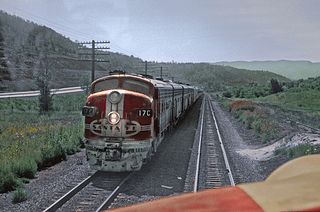
The Chief was an American long-distance named passenger train of the Atchison, Topeka and Santa Fe Railway that ran between Chicago, Illinois and Los Angeles, California. The Santa Fe initiated the Chief in 1926 to supplement the California Limited. In 1936 the Super Chief was introduced, after the Super Chief was relaunched in 1948 with daily departures from LA and Chicago it gradually eclipsed the Chief as the standard bearer of the Santa Fe because of its timetable oriented to the Raton Pass transit. For some the Chief and San Francisco Chief as deluxe integrated trains with both Pullman sleepers and fully reclining coach seating with all facilities; lounges and pleasure domes, available to all passengers were at least equal flagships better suited to the business and executive market. From the mid 1960s the super Chief was only a small entirely separate section of the El Capitan seated vista train, the El Capitan passengers having no access to the Super Chiefs expensive eateries and bars which selling point was exclusion and service. The Chief was discontinued in 1968 due to high operating costs, competition from airlines, and the loss of Postal Office contracts.

The California Limited was one of the named passenger trains of the Atchison, Topeka and Santa Fe Railway. It carried train Nos. 3 & 4 and ran between Chicago, Illinois, and Los Angeles, California.

The Navajo was one of the named passenger trains of the Atchison, Topeka and Santa Fe Railway. The all-coach train began daily service between Chicago-Los Angeles-San Francisco as Train No. 9 (eastbound) and Train No. 2 (westbound) on October 1, 1915, as a replacement for the railroad's Tourist Flyer. In 1936, the westbound train was renumbered from Train No. 2 to Train No. 10. The Navajo was discontinued on January 14, 1940.

The Grand Canyon Limited was one of the named passenger trains of the Atchison, Topeka and Santa Fe Railway. It was train Nos. 23 & 24 between Chicago, Illinois, and Los Angeles, California.
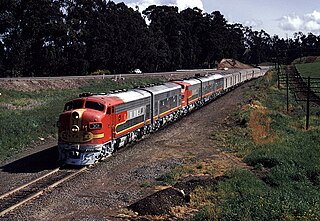
The San Francisco Chief was a streamlined passenger train on the Atchison, Topeka, and Santa Fe Railway between Chicago and the San Francisco Bay Area. It ran from 1954 until 1971. The San Francisco Chief was the last new streamliner introduced by the Santa Fe, its first full train between Chicago and the Bay, the only Chicago–Bay Area train running over just one railroad, and at 2,555 miles (4,112 km) the longest run in the country on one railroad. The San Francisco Chief was one of many trains discontinued when Amtrak began operations in 1971.
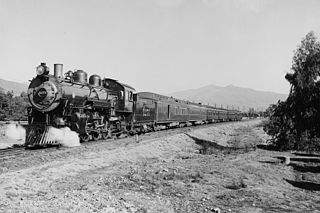
The Santa Fe de Luxe was the first extra-fare named passenger train on the Atchison, Topeka and Santa Fe Railway.

The Capitol Limited was an American passenger train run by the Baltimore and Ohio Railroad, originally between New York City and Grand Central Station in Chicago, via Washington Union Station in Washington, D.C., Camden Station in Baltimore, and Pittsburgh. For almost 48 years, it was the B&O's flagship passenger train, noted for personalized service and innovation. At the time of its discontinuation on May 1, 1971, when Amtrak took over most rail passenger service in the U.S., the Capitol Limited operated between Washington and Chicago.

The City of San Francisco was a streamlined through passenger train which ran from 1936 to 1971 on the Overland Route between Chicago, Illinois and Oakland, California, with a ferry connection on to San Francisco. It was owned and operated jointly by the Chicago and North Western Railway (1936–55), Chicago, Milwaukee, St. Paul and Pacific Railroad (1955–71), the Union Pacific Railroad, and the Southern Pacific Railroad. It provided premium extra fare service from Chicago to San Francisco when introduced in 1936 with a running time of 39 hours and 45 minutes each way.

The Southern Pacific Railroad of Mexico was a railroad subsidiary of the Southern Pacific Railroad in Mexico, operating from Nogales, Sonora, to Mazatlán, Sinaloa. The Sonora Railway was constructed by the Atchison, Topeka and Santa Fe Railway between 1879 and 1882. In 1898 the Santa Fe leased the Sonora Railway to the Southern Pacific in return for the latter railroad's line from Needles to Mojave, California. This arrangement continued until December 1911, when the Southern Pacific purchased both the Sonora Railway and the New Mexico and Arizona. The following June, the Sonora Railway became part of the Southern Pacific Railroad in Mexico."
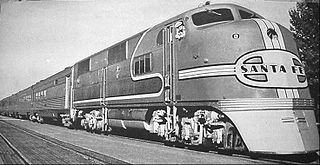
The Golden Gate was one of the named passenger trains of the Atchison, Topeka and Santa Fe Railway. It ran on the railroad's Valley Division between Oakland and Bakersfield, California; its bus connections provided service between San Francisco and Los Angeles via California's San Joaquin Valley.

The San Bernardino Santa Fe Depot is a Mission Revival Style passenger rail terminal in San Bernardino, California, United States. It has been the primary station for the city, serving Amtrak today, and the Santa Fe and Union Pacific Railroads in the past. Until the mid-20th century, the Southern Pacific Railroad had a station 3/4 of a mile away. It currently serves one Amtrak and two Metrolink lines. The depot is a historical landmark listed on the National Register of Historic Places as Atchison, Topeka and Santa Fe Railway Passenger and Freight Depot.

The Texas Chief was a passenger train operated by the Atchison, Topeka & Santa Fe Railway between Chicago, Illinois and Galveston, Texas. It was the first Santa Fe "Chief" outside the Chicago–Los Angeles routes. The Santa Fe conveyed the Texas Chief to Amtrak in 1971, which renamed it the Lone Star in 1974. The train was discontinued in 1979.

The Chicagoan and Kansas Cityan were a pair of American named passenger trains operated by the Atchison, Topeka and Santa Fe Railway. They ran between Chicago, Illinois and Oklahoma City, Oklahoma. The trains were introduced as a Chicago–Wichita service in 1938 and extended to Oklahoma City the next year. A Kansas City–Tulsa connecting train, the Tulsan, was also introduced at that time. The Chicagoan and Kansas Cityan ran until 1968, while the Tulsan ran until 1971.

The Escondido Sub is a 22-mile (35 km) branch railway line between Oceanside, California, and Escondido, California, in the North County region of San Diego County. It is primarily used today by the Sprinter hybrid rail and local freight trains serving Escondido industries late at night, after the last Sprinter train of the day is taken out of service.






















